In 2015, we analyzed the text from 37,259 ads from our Facebook ad examples gallery to find out exactly how the best Facebook advertisers are piecing together their ads.
Today — nearly three years later — this has grown more than 20X: we analyzed 752,626 ads!
While some of our original results have remained constant (the most popular headline is still five words long), a lot has changed.

The information will help underpin the creation of even more targeted and valuable ads in 2018.
There is no better time to dig into the details of what makes a Facebook ad successful.
Read on for more insights from this massive data set!
If you’re here reading you know: AdEspresso is behind the hard-working fella and against the scaremongerers.
We have no gift of prophecy, but “in numbers we trust”, and numbers confirm the fact that Facebook continues to be the top platform for social media advertisers.
Look at this:
- Facebook is still the most popular social media platform by 1.5X.
- In addition, 68% of U.S. adults report that they are Facebook users, with roughly three-quarters being daily active users.
- More than other social media platforms, Facebook users are from a wide range of demographic groups.

Statista data shows Facebook daily active users as of Q1 2018
While other platforms innovate in fits and spurts, Facebook continues its steady upward climb.
And Facebook ads are becoming more and more indispensable to grow any business.
For both our 2015 article and this updated version, we analyzed the text, headline, and news feed link description of the Facebook Ads collected in our ads gallery (less than 40 thousand examples in 2015, more than 750 thousand examples for this round), dissecting them for length, sentiment, and what type of words these ads were using.
We also looked at the Call-To-Action they used and the links in these ads, and how Facebook advertisers were using these to generate as much interest in their products as possible.
To jump to the results of the 2015 study, click here! If you are curious about what’s happening now, just keep on reading.
Important Components of Facebook Ads
Although they appear simple on the surface, Facebook ads have intricacies that marketers can optimize for better campaign results.
To start, you have three options for text fields: the headline, the main text, and the news-feed link description.
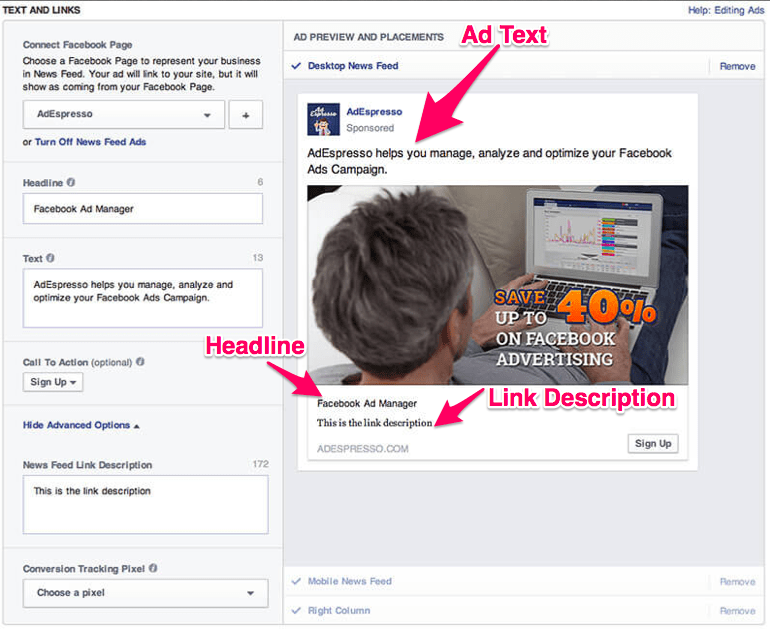 Over time, we’ve observed changes in the length, tone, and word choice in these sections.
Over time, we’ve observed changes in the length, tone, and word choice in these sections.
The right balance in their composition has a strong influence on whether viewers decide to read more, click through to your landing page, spend time exploring and considering your image, and even understand what your company is and what you’re selling.
For example, if your words run over the required length for their specific fields, as in the ad below, the entire post can become dense and frustrating.
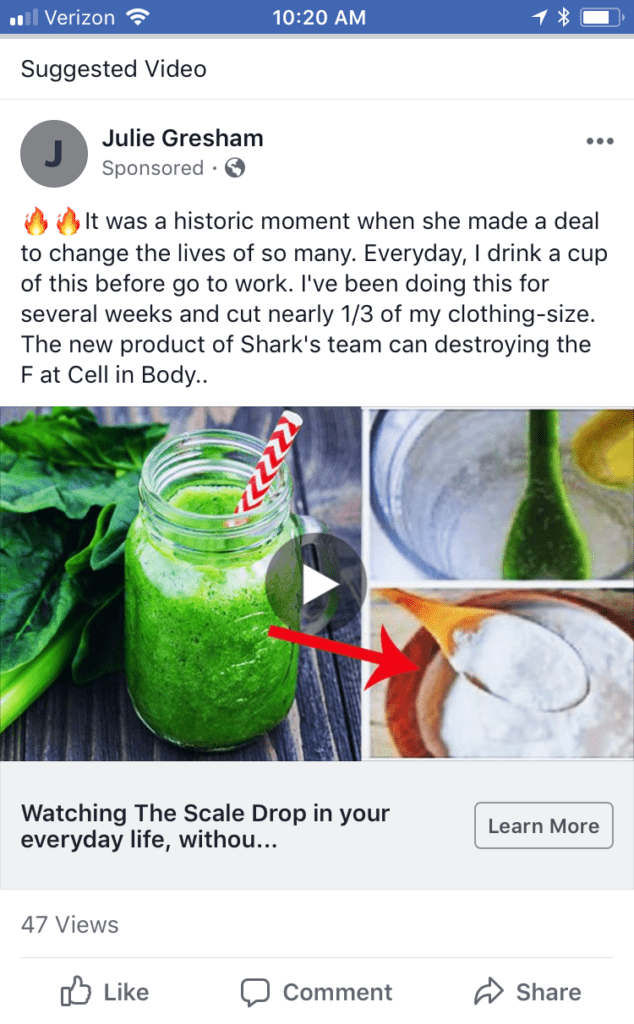
Here, the text is convoluted and missing important points that could guide the viewer to learn more. And we won’t mention the typos and errors -can you spot them?- which are always a No-No!
What could have been an enticing ad for a refreshing, healthful weight-loss product ends up being far less tasteful and effective (for both sales and weight loss, we might guess.)
Studying the subtle ways that brands’ tactics have evolved over the years can help marketers craft ads that are optimized for engagement.
The 5 Key Findings of Our 2018 Research:
- The length of ad text has increased.
- Link descriptions are shorter.
- There has been an uptick in brands that link to specific landing pages.
- The top five CTAs in 2018 and how brands’ usage of CTAs have increased.
- Companies are using a greater variety of Ad types.
The data below, from more than three years of our research, will help marketing teams of all sizes improve their ROI.
1) Headline Length Is Still 5 Words on Average, but Ad Text Has Increased
The message is tried and true: A five-word headline is the perfect length. What has shifted over time, however, is the amount of ad text:
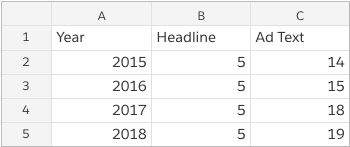
Inching up from 14 words on average in 2015 to 19 in 2018, brands have decided to squeeze more information into this initial field.
This tells us that marketers (1) believe viewers will read more up top and (2) that they’re homing in on content that best hooks viewers’ attention.
Who better to illustrate this than Facebook itself?
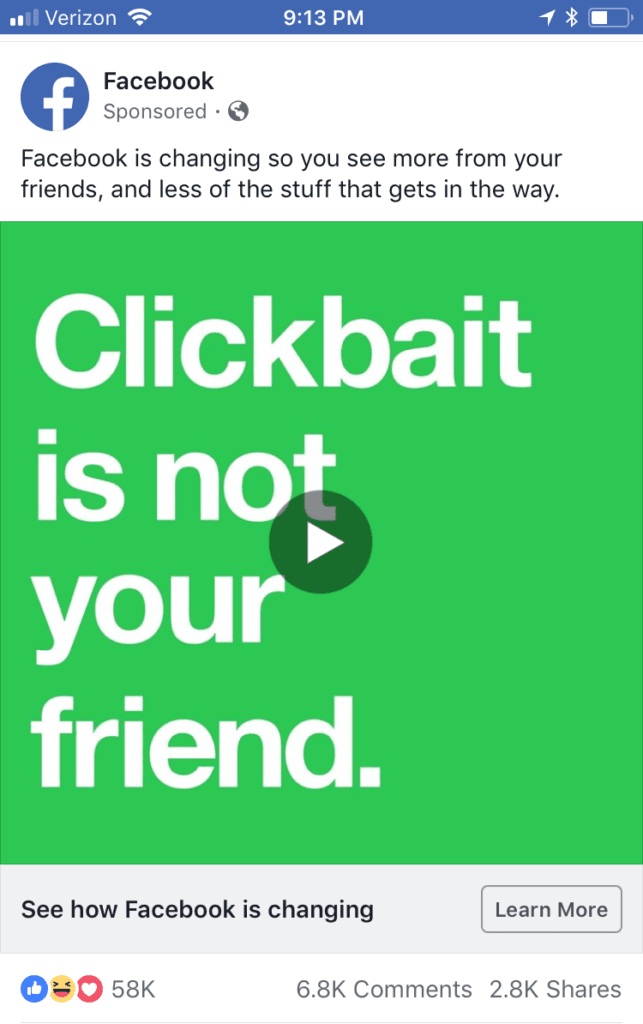
A clear, no-nonsense (and five-word) headline, “See how Facebook is changing,” paired with 20 words of ad text is the recipe for a perfect Sponsored Post.
In the text itself, we see Facebook doing away with regular punctuation and grammar rules — keeping it chill and relatable.
In a time of heightened security risks, particularly around consumer data, if, like Facebook, you store a lot of personal information, it’s absolutely critical to keep an open line of communication with all of your stakeholders — yes, even in your Sponsored Posts!
Although the average length for ad text has increased, it’s still important to find a sweet spot between a catchy description and staying concise.
The travel brand Away struggles with this:

Although the company nails their “Meet the Perfect Suitcase” headline (again — nothing extra, four words, and in line with Facebook’s own recommendation of 25 characters), the ad text is repetitive and quickly becomes boring after the first sentence.
Sticking to the 19-word median will help you stay on point and choose your words carefully, making sure nothing escapes viewers’ notice.
Here are some additional proven tactics for crafting the best headlines:
- Use numbers at the beginning of your headline.
- Create a sense of urgency with limited-time offers.
- Be clear about your offer (avoid being too vague).
- Ask questions that people want to be answered.
Overall, remember to keep your text clear, concise, and relaxed. While ad text has expanded, the most successful posts are still direct and succinct.
2) Link Descriptions Have Become Shorter
In 2015, the average link description was a whopping 18 words. Three years later, it has been whittled down to 13.

Why is this happening? To shed some light, let’s study an example of a link description that doesn’t work:
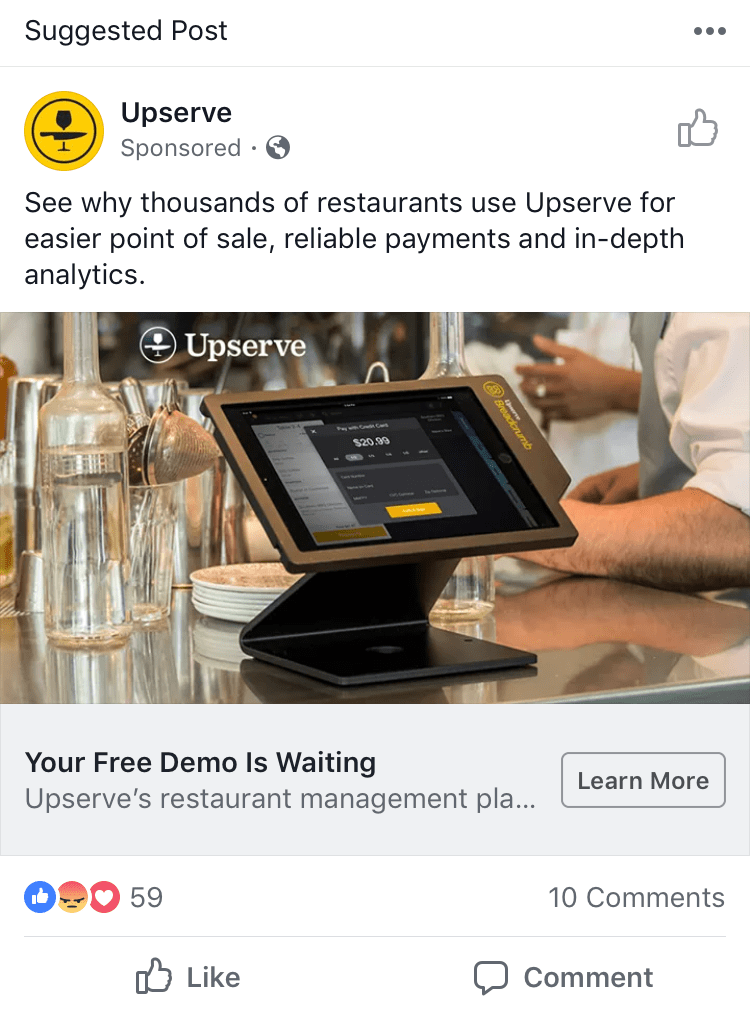
Well exceeding Facebook’s 30-character suggestion, the link description is too verbose and trails off without enough information to prompt the viewer to click the “Learn More” CTA.
Also, it doesn’t add any new information.
Upserve has already mentioned its restaurant management software in the ad text. The link description simply takes up space and makes the post feel crammed.
In contrast, WeWork nails it with a shorter link description that packs the most important information into the space provided.

Although it is below the 13-word average, this four-word link description underscores how less is more.
Facebook has even come out and stated that the average human attention span is just over 8 seconds.
Take this to heart, and don’t push your viewers’ limits with run-on sentences.
3) More Ads Are Using Specific Landing Pages
In 2015, marketers incorporated specific links for viewers in 88.7% of Facebook ads. While the result has fluctuated a bit in the past three years, the overall trend has been upward, with close to 90% of Facebook ads highlighting page links in 2018.
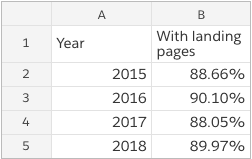
Including landing pages makes a post more direct and removes the effort of additional research for the viewer. Given the heightened attention to ad text in recent years (see Result #1), incorporating your link directly into this field is a great option!
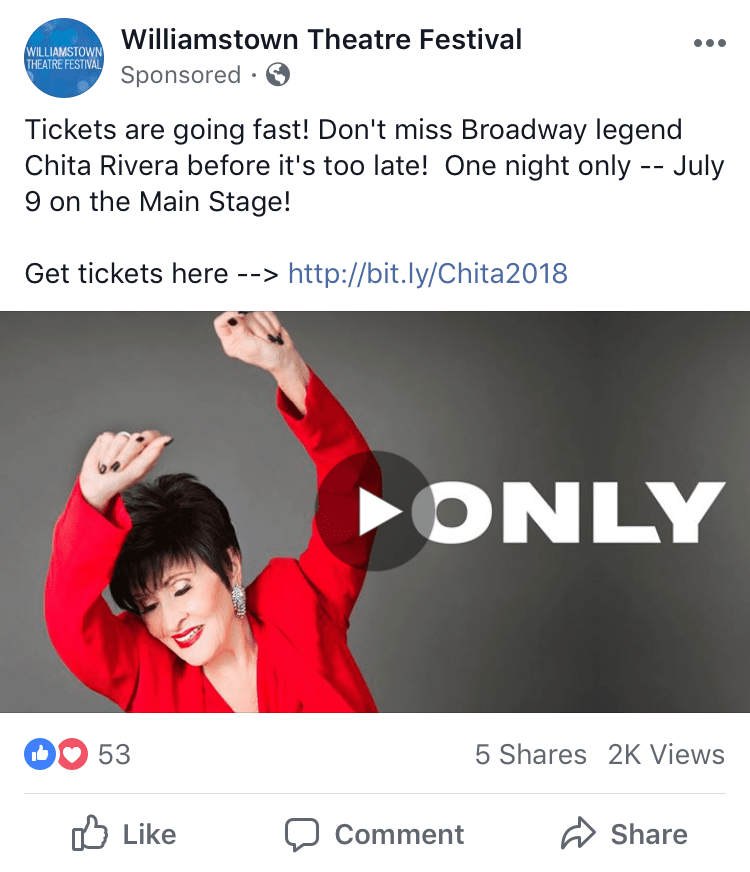
You don’t have to be a big corporation to adopt professional tactics. Above, a small nonprofit, the Williamstown Theatre Festival, displays expert aesthetics by placing its link description front and center.
Pro Tip: Using bitly.com will shorten a longer url into a bite-size piece to fit your word count.
While landing pages are almost always helpful, they’re critical if you’re running Facebook Ads with the objective of lead generation, video views, or conversions. You need to be sure your viewer doesn’t just absorb information from your post but actually takes action!
Back to top
4) Top 5 CTAs: Learn More, None, Shop Now, Sign Up, Book Travel
Choosing the perfect CTA is more difficult than you’d imagine, which is a major reason why this category has seen so many changes over the years. Marketers have experimented with several different kinds of CTAs (including none at all). At the same time, Facebook constantly rolls out new options to test.

Facebook has three main types of ads that are aimed at increasing awareness, consideration, or conversion. Each of these has its own set of CTAs. While some, such as “Comment,” overlap among categories, others, like “Play Game,” are unique to a particular channel.
While the above CTAs are vetted to help drive success on the majority of Facebook ads, branching out and using CTAs that didn’t make the top-five list could set you apart in your viewers’ News Feeds.
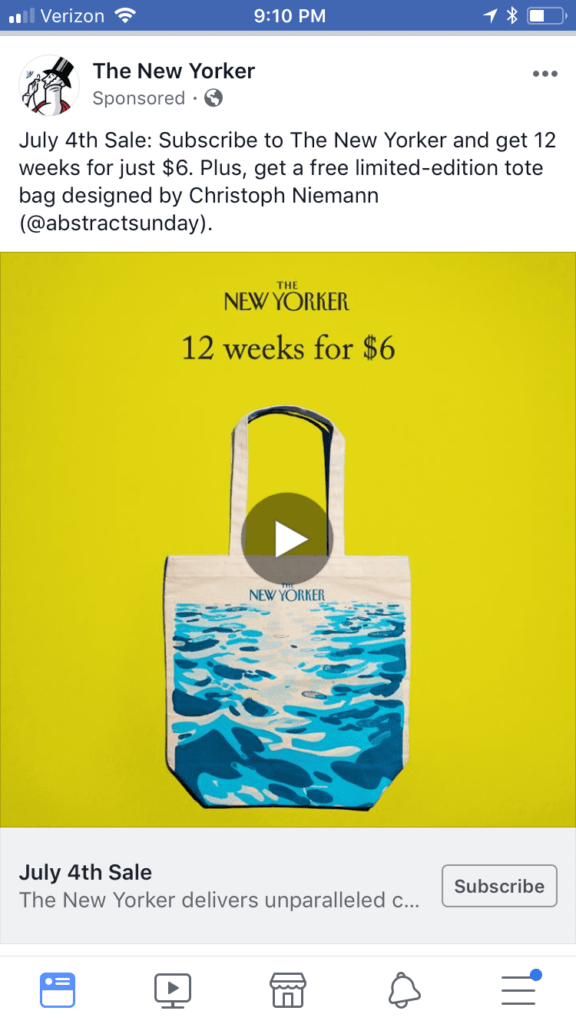
The New Yorker could have gone with a simple “Shop Now” or “Learn More” — but the “Subscribe” CTA is more specific to its objective and is unique among the majority of other offers. It adds an artistic flair to an already-creative brand.
There are more than 30 unique options for Facebook ad CTAs. Here are a few of the quirkier ones:
- Listen Now
- Get Directions
- Donate Now
- Send Message
- Image Click (where the image itself is the CTA)
Whether you go with a vetted approach or one that’s more daring will depend on your brand, your audience, and your ad budget — but having the correct data should always be your first step.
Bonus: Total CTA Count + Usage Per Year
Both the number of available CTAs and the brands’ usage of CTAs have increased 2016–18.

While it might appear that 2018 CTA usage has dropped 2017–18, this data is as of July 2018 (a little over halfway through the year). Given the 40% increase in CTA usage 2016–17, we are on track to see similar growth in this area in 2018. A full breakdown is below:
- 2015: 27 types (46.12% using CTA)
- 2016: 32 types (51.54% using CTA)
- 2017: 36 types (71.64% using CTA)
- 2018: 38 types (69.95% using CTA)
For brands looking for new ways to stay on the cutting edge and differentiate themselves, CTAs are a rapidly expanding opportunity that warrants attention!
Back to top
5) Companies Are Using a Greater Variety of Ad Types
Finally, more companies are deciding to get creative with the new ad offerings Facebook keeps rolling out.

Clearly, video ads have soared in popularity, while links, photos, and events have remained relatively steady or declined.
For more visual learners, another way to view the breakdown of ad types is below:

While traditional links still represent the majority, they are no match for the rapid rise of the video format.
There are so many ways to get creative and stand out with your video ads. And now is clearly the perfect time.
A few ideas from the pros:
- Put the good stuff into the first 5–10 seconds.
- Work in primary colors (red, blue, yellow).
- Incorporate scrolling text.
While you should invest in learning the video format, don’t discount photo ads (particularly with all of the new image technology), which have remained a steady bet since 2015.
Back to the Drawing Board
Take some time, pull yourself an espresso (or two!), and consider how these findings could affect your latest campaign.
Should you increase your ad text?
Cut down your link descriptions?
Maybe it’s time to switch it up and try an underused CTA or take a video course for online marketers.
There are many ways to use this information.
We’re excited to see how you do!
We Analyzed 37,259 Facebook Ads and Here’s What We Learned (in 2015)
We’ve discussed plenty of times before what we think your Facebook ad should say, so we’ve analyzed the text from 37,259 ads from our Facebook ad examples gallery to find out exactly how the best Facebook ads are made.
The Most Popular Headline Is Just 5 Words Long
You have three text fields for the copy in your Facebook ads: The headline, the main text, and the news feed link description:
When you’re putting together the copy for your ad, we have one piece of advice: keep your copy short and extremely clear.
It seems Facebook advertisers have taken this to heart.
The median length for a headline is just 5 words long.
This means that their ad is immediately clear and to the point each time.

This example from Thinkful shows a great ad.
Not only is the headline nice and tight, but all the text is to the point. It gets your attention and then makes you want to click through to the site to find out more:

A few advertisers are making their headlines way longer than this and immediately losing the focus.
This ad from Video Game Testers & Designers puts too much information into the headline — information that should be in the text.
They even have an asterisk to explain more because they can’t fit it all in the headline:
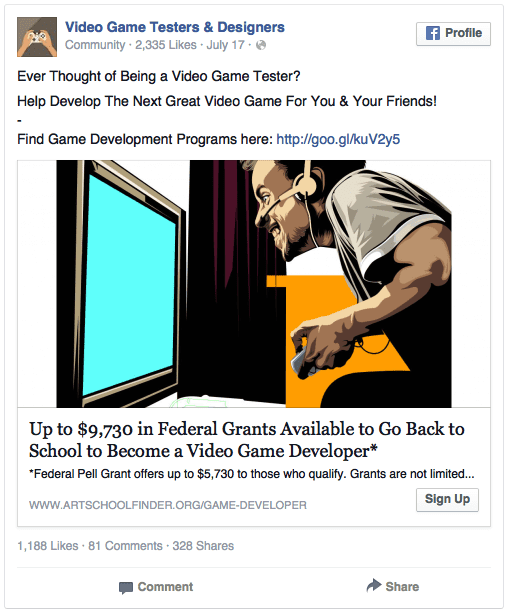
Post Text And Link Descriptions Are A Little Longer (But Not Much)
The median length for ad post text is just 14 words long, again keeping it short and to the point.
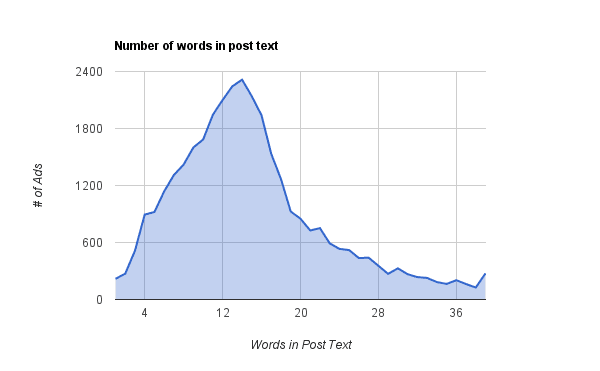
The link description is a little longer, at 18 words.

The post text for this ad from Gwynnie Bee has just the right amount of information in its 14 words:
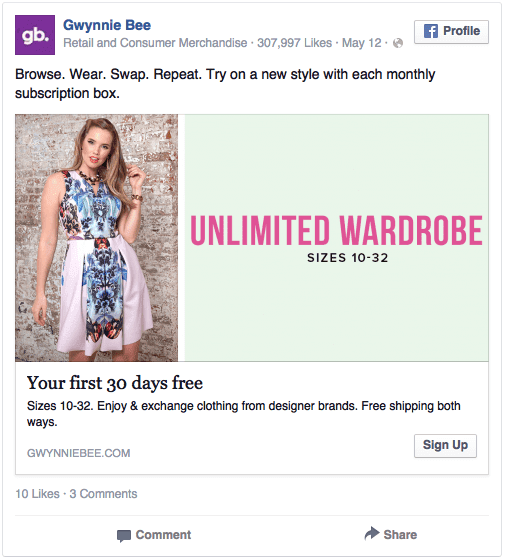
We strongly suggest you keep your text tight and to the point.
Facebook ads are expensive real
estate, and aren’t there to tell your life story. Instead, use clear and catchy text to attract people to the ad, and then let them click through to your site to learn more about your service.
The Most Popular Word: You
Looking at the ad examples dataset this was one of my favorite things. It seems that Facebook Advertisers really are on their game.
Recently I wrote about the best psychological tricks to make your ads unforgettable and included a list of the 5 words that you should always include in your ad if you want people to respond:
1) You
Why is a simple “you” so powerful? Because it makes you think of you.
If every ad could be hyper-personalized that would be even better, but in lieu of that, the word you will suffice. Our brain is activated specifically by hearing or thinking of our own name and ourselves.
2) Free
We value free highly. Free is the ultimate word for any viewer of an ad.
We are always on the lookout for free. Including it in an ad and it’s almost guaranteed to catch the eye.
3) Because
We want answers.
Humans are inquisitive souls. We are constantly questioning why? And because of that the word because means a lot to us.
4) Instantly
We love now. We discount things drastically into the future, so instantly nearly always seems like the better option.
This has been backed up by brain scans, showing that if you offer something instantly, our brains go crazy.
5) New
We are novelty-seeking animals, so using new is a great way to show you are something fresh, or re-invigorate an established brand and put it back into the customer’s mind.
Here is a word cloud of the text from these 37,259 ads, where the size of the word is proportional to how often it occurred in all the fields.
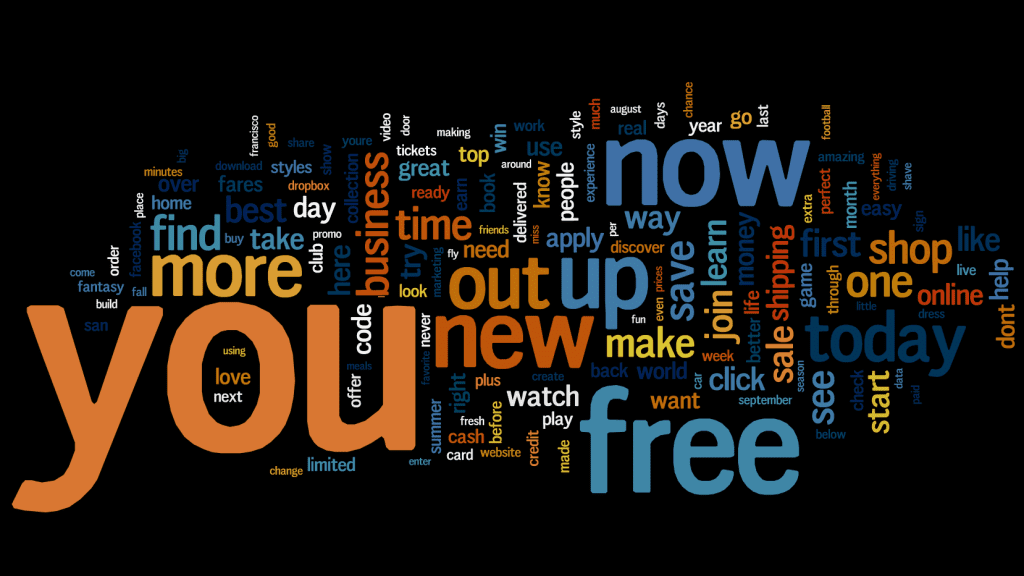
OK, so ‘because’ isn’t there, but ‘you’, ‘free’, ‘now’ (instead of ‘instantly’), and ‘new’ are the words that you find most frequently in these ads.
Well done guys!
Here are a couple of examples of advertisers using these words well.
First Hit the News using ‘You’ in their ad, making readers wonder if you are happy together:
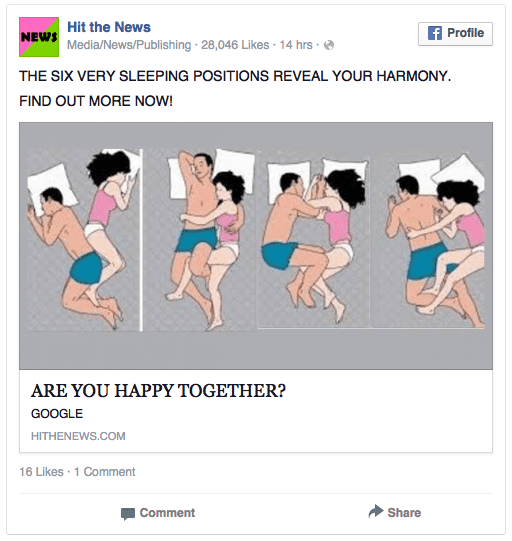
Then General Assembly using the awesome power of free to get people to learn to code:
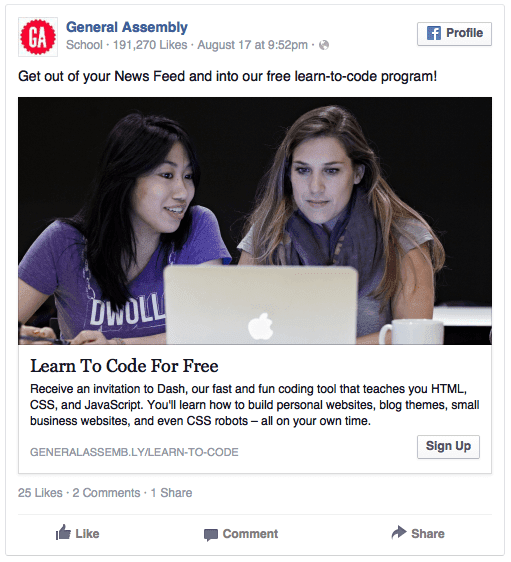
These words work.
We are naturally drawn to these words as they signal something powerful to us. Using them in ads means you have a natural advantage over all other advertisers.
If You Want To Stand Out, Go Negative
Sentiment analysis is a way of analyzing text for how positive or negative it is. Certain words are assigned a valence score and you add up the scores for each word in a document to determine the text’s sentiment, either positive or negative.
Most ads are neutral, either because the words aren’t scored in the valence database (it only has scores for about 2000 words in the English language), or because positive and negative words in the ad have canceled each other out. Below you can see ads that were either positive or negative (0 scores have been removed).

The graph is skewed towards positive valence, with most non-neutral ads showing a slightly positive tone. These ads might contain words like ‘capable’ (+1), ’top’ (+2), or ’yummy’ (+3).
This ad for Lays scores highly because it has the word ‘yummy’ (+3), and ‘win’ (+4):

This DraftKings ad has high valence words such as ‘top’ and ‘win’ multiple times.
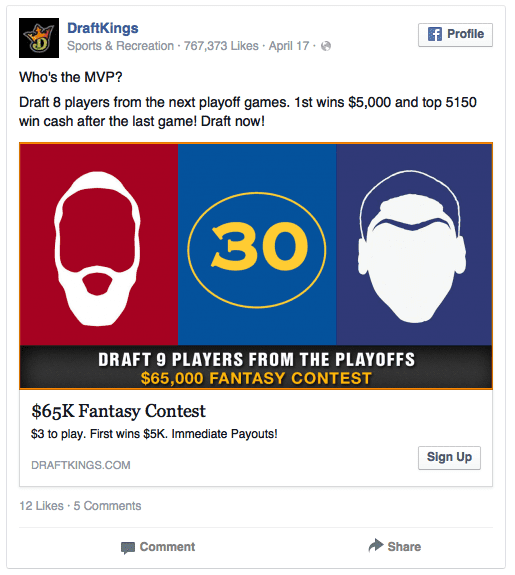
The ads that are really positive in tone, with a sentiment score of 5 or more can either be made up of a few of these slightly positive words (super-yummy or win-win-win), or might have extremely high valence words like ‘breathtaking’ (+5), as this VideoBlocks ad includes:

Not all the ads are positive though.
Ads for news items or charities are often slanted slightly negatively.
This Soi Dog ad contains the words ‘cruelty’ and ’torture’, scored as -3 and -4 respectively:
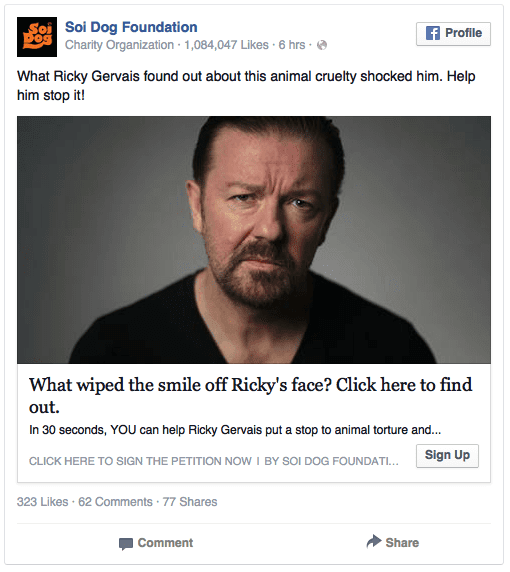
It will definitely grab a user’s attention, especially with the image of Ricky Gervais as well.
The PandoDaily ad below, scores slightly negatively because of the inclusion of the words ‘war’ and ‘hurting’:

Of course, looking at this data it seems there is one way you can get your ad to stand out from the rest – go negative.
If your ad is all the way off to the left of that chart, it will definitely stand out from the rest (though will people click on it?)
CTAs Aren’t Being Used Effectively
Including a call-to-action (CTA) button in your ad makes it easy for a user to click through to your site to learn more about your product, sign up to a service, or to download an eBook, app, or game.
From the possible CTAs available to Facebook advertisers, our analysis showed that only a few are really used extensively:

‘Learn More’, ‘Shop Now’, and ‘Sign Up’ are all used significantly more than any other call-to-action.
Below is a word cloud of the CTAs, with the size of the words proportional to how often they appeared in the ad example gallery.
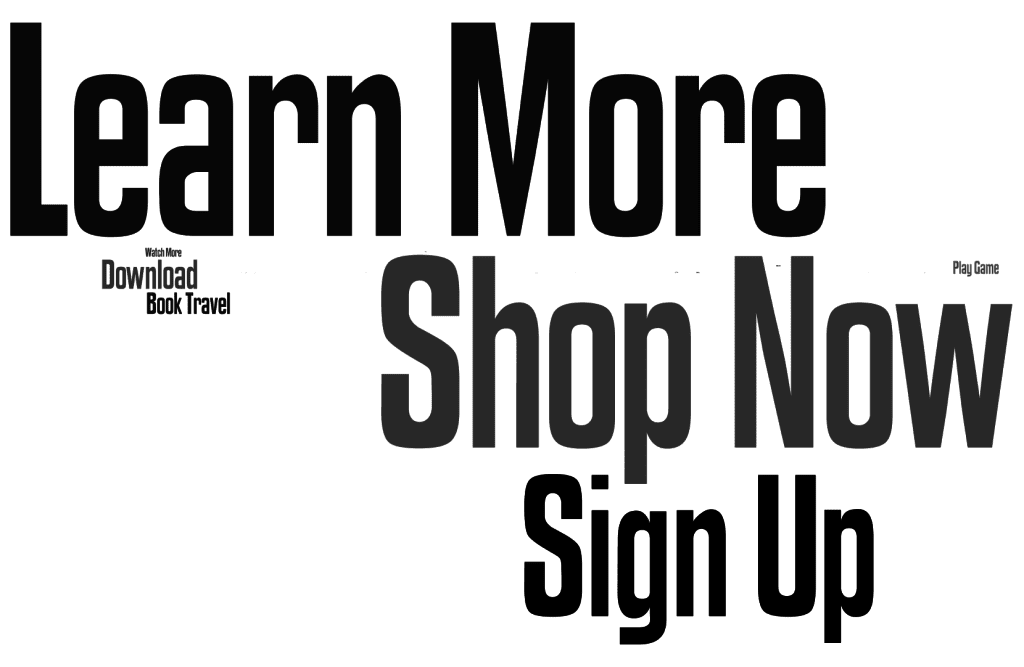
The less-used ones, such as ‘Open Link’, or ‘Use App’ can barely be seen (they are the ones that look like an Umlaut above the ‘p’ of Shop).
Using a CTA makes it easy for a user to find out more about your product, and shows them exactly where on the ad they should click to get the information.
Kabbage uses the ‘Learn More’ CTA so you can find out about their small business funding:

Don’t be scared of using those lesser-used CTAs though, if they have relevance to your service.
Here Angel Stone uses the ‘Play Now’ CTA exactly as it should be used — to get people to their gaming site:

In total, only 56% of ads included a CTA, so this is an area where Facebook advertisers could really up their game, making it easier for users to click through to their sites to Learn More, Sign Up, or Donate Now.
69% of Ads Link To A Landing Page
Basic Facebook ads rules:
- Your Facebook ad should be advertising something specific, rather than just your site or whole service.
- Your Facebook ads should be targeted towards a specific audience, and you should offer them something that is unique to them.
- Your link from the ad should be pointed to a specific landing page for your service.
This is what most advertisers are doing:

69% of Facebook ads point to a specific referral or landing page on the product site. 11% of ads miss out on this targeting by pointing to the home page instead, and a further 20% point to another page within Facebook instead of moving out of the site to a product or service.
The Localytics ad below, does it right by sending the user to a specific landing page for their eBook:
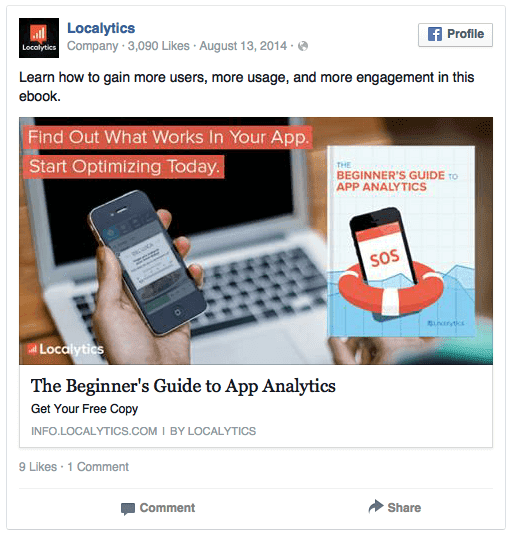
Why do we suggest have a specific landing page for your click-throughs? Because this is a great way to use Facebook ads for Lead Generation.
You can then create a dedicated landing page for your lead magnet, using apps such as Welcome Mat from SumoMe, and capture information about your customers easily.
If you are going straight to your home page, or to another page in Facebook, you’ll lose this information and lose customers.
Most Companies Only Have 1 Ad, But The Best Have 100s
Our final task was to look at how many ads each advertiser had in our gallery.
Unfortunately, most advertisers had only 1 ad in the gallery.
This is a massive mistake.
It means they are only putting up 1 ad for their product. They’re not taking advantage of ways to optimize their campaigns, such as split testing different designs or text.

We did find a few companies that were doing to awesomely though.
Shopify has over 200 examples in the ad gallery, using different images and text in each, to attract a different type of user.

In the images above and below, you can see 3 different Shopify examples with the same headline, but different images and text for different personas:

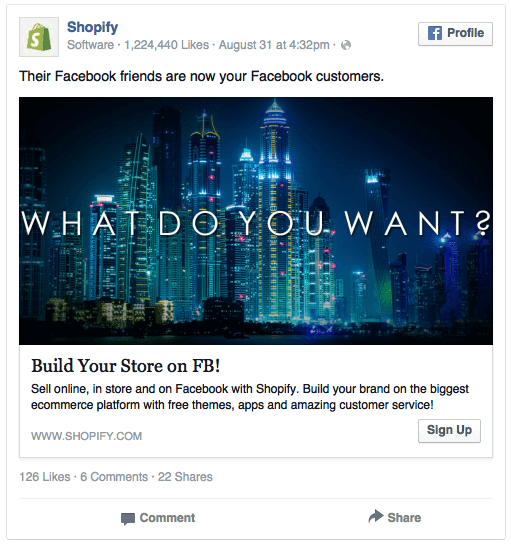
Awesome work, Shopify!
Wrapping It Up
It seems that most Facebook advertisers really hit the mark.
They keep the text nice and short, keep the ads positive, and even if they aren’t always using CTAs, they link to specific landing pages on their own sites so they can capture important user information.
Where they are letting themselves down is by not producing more ads, so they can’t optimize their campaigns effectively.
If they did this, I’d expect there to be even better data in the other categories.
Are you playing by these rules?
Or can you see ways of subverting these norms, such as going negative, to make your ads stand out even more?
We’d love to hear about your strategies to optimize your ads and to get them to stand out from the rest! Drop us a comment and let us know!
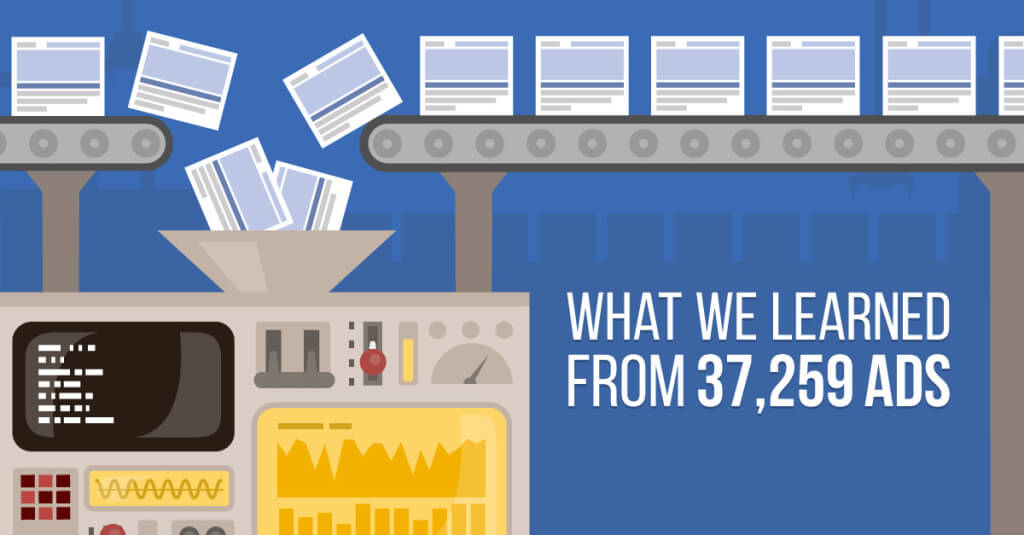
Hi Andrew…Thanks for share those examples.
I have a question???? I see some Ads here with more than 20% Text….How do you do to be approved by Facebook???
Thanks a lot
The approval process is still mainly human based… from time to time some ads will slip through the cracks of the door and gets published even if they break the 20% rule 🙂
Ad review is done on a manual level at some point, so it also depends on the person.
I’ve literally had an image approved for one entire campaign and then rejected for a different campaign (targeting a similar niche though).
Awesome post
Thanks for the article.
Btw do you guys have any data on images, specifically vectors vs. photos? Or even if adding text on images works or doesnt work?
And is there a platform I can use to do the same analysis of my ads like this one? I dont think I see anything in AdEspresso that will let me do this.
While it is great to see what others are doing, it doesn’t mean that they are doing it right. Saying that most companies have five word headlines simply tell us that mediocre it’s five words. It doesn’t say if five words is the best possible response rate. Maybe one word headlines have ten times the draw power. This analysis tied to actual performance would be useful instead of simply pointing us to average.
I agree. Although this is an informative post, it does not shed light on the effectiveness of these ad campaigns.
This is another great read! Great job guys!
Regarding the 20% ads, if once you got passed throught the restriction and you aware of that, you should not edit the ad as they will go again trought reviewing.
Also, consider why are you putting text in the imagine. I see no real value adding long texts, so keep it short and go on “real life images” on user sentiments rather than writing long (and boring) copy on the images.
The shopify ads amaze me with the difference between the products they promote and the tone of the images used in ads. But I bet they are having big CTR’s.
Also, if you have a big budget, maximising the number of ads will attract more attention from the users as a high frequency of the same ad eventually goes in the “Ad blindness” spot.
Great and interesting post but how do you know the median or popular ads are the ones which are converting? It’s quite rare that popular = successful in actual ROI for a business.
For example the point for “The Most Popular Headline Is Just 5 Words Long” while popular, I’m not confident that yields ROI (in almost all the campaigns I’ve been involved in anyhow that have been profitable).
Great post and aggregation of data though, I do agree 100% with “Most Companies Only Have 1 Ad, But The Best Have 100s” though. Split testing is king.
Exactly. I had the same thoughts.
Hey Stephen, you’re right, the goal of the article is to show you a great overview of what advertisers are doing today, not what is performing.
The Ads Gallery is based on Ads that we find on Facebook, they are not coming from our internal database for the Ads Manager so we don’t have performance indications for these ads.
We may publish something anonymized with our own internal data in the future, but still we think it’s very useful to see what are the trends in Facebook Advertising now!
Cheers,
Max
Great article. I recently started using FB ads. I used it for 2 different campaigns. Our First AD was successful. We got great response (conversions) than we expected and in second ad didn’t got any leads. I learned a lot in those 2 ads. Do it properly, use catchy headlines, mention exactly what you are giving through your landing page.
Wow. Great write up and with good data to back it up. Other important things are how targeted the ads are to the visitors. Showing ads using Facebook retargeting and proper demographics filtering is equally as essential as proper ad copy IMO.
All the tips made perfect sense. What stuck to me the most is this “keep your copy short and extremely clear” which is, for the obvious reason, imperative. So, thanks!
Great for Facebook ad campaign strategists. thanks for the article.
Very interesting both article and comments will try to follow more to come in free time.
Great article!
I think it would be even more interesting to see how these practices correlate with good convertion rates and by different verticals.
Thanks!
Unfortunately, the advice for shorter titles, etc is based on assumptions. You’re concluding that just because most ads are short that ad titles a house be short. But what if most people have it wrong. I mean, sure I could quite be true that short as title preform better but you’re not basing your conclusions on performance you’re basing it on what “everyone” does. Just some good for thought.
Hey Sean, absolutely, this is meant as an overview of what advertisers are doing in these days. There’s no assumption that this actually works. Facebook really changes a lot with time and industries. What works in B2B may not work in B2C and vice versa.
Sorry if that was not clear enough in the article!
I was going to say the same thing. My headlines are over 400 words and I am getting ROI in the 2000% plus range.
Most people are doing FB ads wrong so just to say what is popular doesn’t say anything about if it is working out not.
You must do A/B tests to figure those things out.
Also there’s no one-size-fits-all solution. The length of the text should be calibrated on your industry and how good you are at writing 🙂
Thank you for a relly great and useful article. I am looking forward to read more of this on your blog!
this is a great article, i was in a marketing seminar this weekend and you shared similiar information here and a lot more value, thanks, learned new stuff.
Hi!
Thanks for the write up! Interesting insights. Just wondering, people are suggesting you do split tests for your ads. Those only work if you have a lot of traffic right? Otherwise they aren’t statistically significant? I get that shopify does split testing, but a startup with not a lot of traffic can’t conclude on results from a split test with low traffic.
What are your thoughts on that?
Even with low volumes you can easily split test. You won’t be able to test 100 ads at the same time but even at a $10/day budget you can reach statistical significance if you make just few experiments.
My Advice is to do bold experiments. Don’t test just a few words differences or the color of the button. Test very different designs or target. The bigger the difference the less data you’ll need to reach statistical significance!
Well this is one awesome post with a lot of useful data. I started creating campaign for my company on Facebook, and just remembered that i saw this post on growthhacker.
Will apply most of this suggestion and test at least 10 different ads for start.
Tnx
Great article, thanks – I have found this very useful. However, I have a question (or point that I’d like to clarify) about your first example of Thinkful (a good example of short heading) versus Video Gamer Testers (a bad example). The good example has 73 likes, 6 comments and the ‘bad’ example has 1188 likes, 81 comments. On immediate viewing – one would assume that the Video Gamer post actually outperformed the Thinkful post based on these engagement points – do you have some other evidence such as CTR to indicate high performance of the Thinkful ad? Your thoughts would be appreciated. Cheers
Excellent items from you, man. I’ve remember your stuff prior to and you’re simply extremely fantastic.
I actually like what you have got here, really like what you’re saying and the best way through which you
say it. You are making it entertaining and you still care for to stay it smart.
I can not wait to read far more from you. This is really a tremendous website.
Wonderful blog! Do you have any suggestions for aspiring writers?
I’m hoping to start my own blog soon but I’m a little lost on everything.
Would you recommend starting with a free platform like WordPress or go for a paid option? There are
so many choices out there that I’m completely overwhelmed ..
Any ideas? Appreciate it!
It is SEO friendly to make your real estate website easy to
find on Google and other search engines.
Wonderful blog! Do you have any recommendations for aspiring writers?
I’m planning to start my own website soon but I’m a little lost
on everything. Would you suggest starting with a free platform like WordPress or go for
a paid option? There are so many options out there that I’m totally confused
.. Any tips? Thanks a lot!
Good and very informative article. Keep up the good work AdEspresso! Cheers
Hi, I think your site might be having browser compatibility
issues. When I look at your website inn Safari, it
looks fine but when opening in Internet Explorer,
it has some overlapping. I just wanted to give you a qyick hads up!
Other then that, fantasric blog!
Hi 🙂 I asked the IT guys the solution they suggested is to upgrade to the latest Explorer version! 🙂 cheers and thanks for the compliments
So anytime I run an ad (on a fitness / health related page) and I use the word “You” – Facebook doesn’t approve it because they think we’re objectifying people.
And all we generally put is something like “Are you ready to get fit?” or “Does gym equipment confuse you? Here’s a guide to help…”
The Right Column and Mobile placements barely give you a line or two. While the News Feed gives you a little room to work with. The median ad post text is only 14 words long, while the link description is around 18 words,
thanks a lot for this amazing info about facebook ads,i just started using them and this article was really helpfull for me…if you can please write more about this topic 🙂
Thanks for this, very helpful. Most of my ads, I don’t do instagram and the desktop right column. In my opinion, right column hardly converts (too much restrictions on the ad copy and text). Can you do more posts on Facebook ads and do you know of any good tools you recommend for analysing live ads? Also one of my recent ad got disapproved saying the image had too much text, any way to get past that?
I was more of an AdWords guy for doing my promotions but I’m doing a lot of facebook ads lately and learning, do you plan on to doing some article related to re-targeting ads anytime soon? By the way, can you promote affiliate links with facebook ads, I’m not sure, I’ve only tried sending to a capture page, never to a product directly.
Re: Affiliate Links – you can check
THE ULTIMATE GUIDE TO FACEBOOK ADS FOR AFFILIATE MARKETING
Re: re-targeting – check these posts
4 Facebook Ad Retargeting Strategies You Need to Try
Why You Can’t Afford to Skip RetargetingThe Ultimate AdWords Retargeting GuideHow to Make the Most of Your Retargeting No Matter What You’re Marketing
Great info. Thanks for taking the time to write it. Very good article.
Really great study.
Some facts are really surprising. Keep it up. I think AdExpresso is the best place to learn FB Ads.
Great stats Andrew. Always like to read “What we learned” articles especially from Adespresso.
However 20% rule doesn’t apply all the time, like someone mentioned, sometimes its get approved and sometimes not.
Anyway, shared this article to my personal bookmark https://moon.ly
Peace,
Great insights, even if correlations with the ROI on these ads cannot be done. But the information is very useful, and we all beginners or advanced ads specialists can use it to test our ads. Split testing is vital, and even having the info that a 5 words headline has x% conversion rate doesn’t mean the same performance will be achieved, as audiences are different.
We’re a bunch of volunteers and opening a brand new scheme
in our community. Your web site offered us with valuable info to work on. You’ve performed a formidable job and
our whole community can be thankful to you.
‘Book Travel’ isn’t an available CTA though?
I just wanted to write down a quick comment so as to say thanks
to you for some of the nice instructions you are giving out
at this website. My time-consuming internet look up has now been rewarded with extremely good concept to talk about with my two friends.
I would suppose that many of us website visitors actually are rather fortunate
to exist in a fine network with many outstanding professionals with very helpful strategies.
I feel truly privileged to have used the weblog and
look forward to tons of more exciting times reading here. Thanks a
lot once more for everything.
This is very fascinating, You’re a very professional blogger.
I’ve joined your feed and look forward to seeking more of your excellent post.
Also, I’ve shared your site in my social networks
Hello! Do you have a newer analysis? And have you noticed whether some ads trigger more bad comments than others?
Thanks for sharing an fabulous article. This research helps us alot in creating better Facebook ads .
I savour, cause I found just what I used to be taking a look for.
You have ended my 4 day long hunt! God Bless you man.
Have a great day. Bye
This article saved me a lot of money
Not only is it interesting to study the ads but also their offers. Really loved this indepth article – gave me a lot of ideas for my own campaigns.
I was disappointed in the findings that if you want to stand out you go negative. I think advertising to people’s fears has long-term detrimental effects. Even if you need to use a negative stance I think it’s always important to bring it back with something positive in the end something that the potential customer can believe in. Thanks
I was very upset about post boost engagements. I spend a lot of money in the last few months. But didn’t receive good results.
I’d like to thank you for sharing this update about Facebook Ads. If you share more details about the new update, that will help me. How to increase more engagements on every boost on Facebook ads?
Thanks and waiting
It was very nice to read this article. The reason that I found very interesting is that even now more than 60% of the campaigns where link click campaigns according to your studies.
Really an amazing article.
I have also researched for Facebook ads and they are really growing very fast. Also, Instagram added a very high value to Facebook promotions. Facebook has a lower conversion rate than Instagram, but Facebook is base of all social platform due to the largest number of users.
Very useful. Thanks for posting it.
Great article. I recently started using FB ads. I used it for 2 different campaigns. Our First Ad was successful. We got great conversions than we expected and in the second Ad lower. I learned a lot in those 2 examples. Do it properly, mention exactly what you are giving through your landing page and that’s it!
Love this piece! Thanks for publishing
Wanted to throw in my two cents:
Unlike traditional creative, which traditionally had the purpose of being clever, cool or fun, performance creative is highly focused on getting the customer to accomplish a specific task. Most notably, buying something.
What’s surprising is seeing which ads perform the best. You may think one ad is more inclined to win, but that’s not always the case. But you can learn quickly and iterate on the fly. With performance creative, we can’t overstate the importance of experimentation.
Your brand has several levers to pull in terms of testing, i.e., the call to action, the copy and the creative. And depending on which ad you’re running, each lever will differ in their effectiveness.
We wrote a post about this the other day if you want to check it out:
https://bit.ly/2w2jcn6
Hope that helps!
The 5 points mentioned are spot on. Nice work as far as research is concerned. As a frequent user of Facebook ADs, I can relate. I think Facebook Ad system still is not as user friendly. But it is improving continuously and people getting more used to it. So we will get there. Helpful for the first timers.